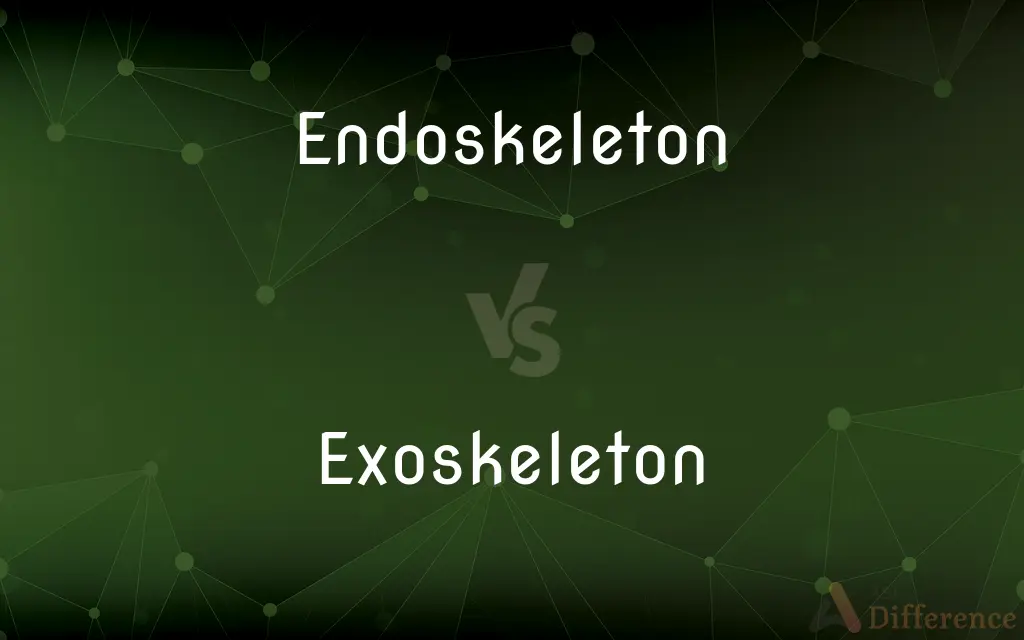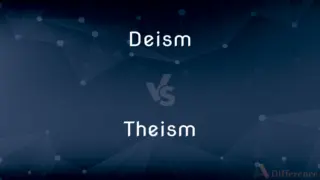Endoskeleton vs. Exoskeleton — What's the Difference?
By Urooj Arif & Fiza Rafique — Updated on March 21, 2024
Endoskeletons are internal support structures found in organisms like humans, providing support and facilitating movement, while exoskeletons are external, hard protective layers found in creatures like insects, offering protection and structural support.

Difference Between Endoskeleton and Exoskeleton
Table of Contents
ADVERTISEMENT
Key Differences
An endoskeleton is an internal skeleton made of bone and cartilage, found in vertebrates including humans, mammals, birds, and fish. It provides structural support, facilitates movement through attachment points for muscles, and protects internal organs. Whereas, an exoskeleton is a hard, external shell made of substances like chitin in insects and crustaceans. It offers protection from the environment and predators, serves as a support structure for the body, and plays a role in movement by providing rigid areas for muscles to attach.
The material composition of endoskeletons and exoskeletons differs significantly. Endoskeletons are primarily composed of living tissue, including bone and cartilage, which can grow and repair itself. On the other hand, exoskeletons are made of non-living materials such as chitin in insects and calcium carbonate in some marine animals, which cannot grow with the organism, necessitating periodic molting for the organism to increase in size.
Endoskeletons allow for continuous growth throughout an organism's life due to their internal placement and the living nature of their materials. This growth is accommodated without the need for the organism to shed and regrow its supportive structure. Conversely, organisms with exoskeletons must undergo molting, shedding their external shell to allow for growth, which can be a vulnerable time for these organisms as they wait for their new exoskeleton to harden.
The location of the skeletal structure has implications for the organism's overall size and weight. Endoskeletal structures, being internal, allow for the development of larger and heavier organisms, like elephants and whales, due to their ability to support substantial body mass. Exoskeletons, meanwhile, are more limiting in this regard; the weight of an external skeleton increases non-linearly with size, making it impractical for very large organisms due to issues with mobility and structural support.
While both types of skeletons serve the primary functions of support, protection, and aiding in movement, they offer different advantages and constraints to the organisms that possess them. Endoskeletons provide the benefit of growth and repair, supporting larger body sizes, while exoskeletons offer immediate physical protection but limit growth and require molting to accommodate size changes.
ADVERTISEMENT
Comparison Chart
Location
Internal
External
Material
Bone and cartilage (living tissues)
Chitin, calcium carbonate (non-living materials)
Growth
Accommodates continuous growth
Requires molting for growth
Repair
Capable of self-repair
Cannot self-repair; damaged parts are permanent
Support and Size
Supports larger body sizes
Limits body size due to weight constraints
Protection
Protects internal organs
Offers external protection from environment
Organism Examples
Humans, mammals, birds, fish
Insects, crustaceans, arachnids
Compare with Definitions
Endoskeleton
Composed of living tissues, allowing for growth and repair.
Bone fractures in an endoskeleton can heal over time.
Exoskeleton
A hard, external shell that protects and supports an organism.
The beetle's exoskeleton protects it from predators.
Endoskeleton
A framework within the body that grows with the organism.
The endoskeleton provides attachment points for muscles.
Exoskeleton
Requires molting for the organism to grow.
Spiders must molt their exoskeleton to increase in size.
Endoskeleton
The structural support system within vertebrates.
Fish rely on their endoskeletons for movement through water.
Exoskeleton
Made of non-living materials like chitin or calcium carbonate.
Crabs have exoskeletons made of calcium carbonate.
Endoskeleton
Supports and enables the movement of larger organisms.
The whale's endoskeleton allows it to be one of the largest creatures.
Exoskeleton
Provides external protection and support.
The exoskeleton of a lobster shields it from environmental hazards.
Endoskeleton
An internal skeleton made of bone and cartilage.
The human endoskeleton includes the skull that protects the brain.
Exoskeleton
Limits the size of the organism due to weight constraints.
The structural limitations of exoskeletons prevent insects from growing too large.
Endoskeleton
An endoskeleton (From Greek ἔνδον, éndon = "within", "inner" + σκελετός, skeletos = "skeleton") is an internal support structure of an animal, composed of mineralized tissue.
Exoskeleton
An exoskeleton (from Greek έξω, éxō "outer" and σκελετός, skeletós "skeleton") is the external skeleton that supports and protects an animal's body, in contrast to the internal skeleton (endoskeleton) of, for example, a human. In usage, some of the larger kinds of exoskeletons are known as "shells".
Endoskeleton
An internal supporting skeleton, derived from the mesoderm, that is characteristic of vertebrates and certain invertebrates.
Exoskeleton
A hard outer structure, such as the shell of an insect or crustacean, that provides protection or support for an organism.
Endoskeleton
(anatomy) The internal skeleton of an animal, which in vertebrates is composed of bone and cartilage.
Exoskeleton
See exoskeleton suit.
Endoskeleton
The bony, cartilaginous, or other internal framework of an animal, as distinguished from the exoskeleton.
Exoskeleton
(anatomy) A hard outer structure that provides both structure and protection to creatures such as insects and Crustacea.
Endoskeleton
The internal skeleton; bony and cartilaginous structure (especially of vertebrates)
Exoskeleton
The hardened parts of the external integument of an animal, including hair, feathers, nails, horns, scales, etc.,as well as the armor of armadillos and many reptiles, and the shells or hardened integument of numerous invertebrates; external skeleton; dermoskeleton.
Exoskeleton
The exterior protective or supporting structure or shell of many animals (especially invertebrates) including bony or horny parts such as nails or scales or hoofs
Common Curiosities
Why do organisms with exoskeletons undergo molting?
Organisms with exoskeletons undergo molting to shed their external shell and grow, as their non-living exoskeleton cannot expand with them.
What is an endoskeleton?
An endoskeleton is an internal skeletal structure made of bone and cartilage, providing support, facilitating movement, and protecting internal organs in vertebrates.
Can endoskeletons repair themselves?
Yes, endoskeletons can repair themselves since they are made of living tissue, allowing for the healing of injuries such as bone fractures.
What limits the size of organisms with exoskeletons?
The weight of the exoskeleton increases disproportionately with size, limiting the size of organisms because larger exoskeletons would be too heavy and hinder movement.
Do all animals have either an endoskeleton or an exoskeleton?
Most animals have some form of skeletal support, whether an endoskeleton or an exoskeleton, but there are exceptions, such as certain soft-bodied invertebrates like jellyfish.
What advantages do exoskeletons provide to their bearers?
Exoskeletons provide several advantages, including strong physical protection against predators and environmental factors, support for the body's structure, and aiding in the prevention of water loss in arthropods.
What role do muscles play in organisms with endoskeletons and exoskeletons?
In organisms with endoskeletons, muscles attach directly to the bone, facilitating movement by contracting and pulling on the skeleton. In organisms with exoskeletons, muscles attach to the inside of the exoskeleton, and movement is achieved by the muscles contracting within the rigid outer shell, demonstrating a fundamental difference in how movement is facilitated in these two skeletal systems.
What is an exoskeleton?
An exoskeleton is a hard, external shell that offers protection and structural support to certain invertebrates, like insects and crustaceans.
How does the growth process differ between organisms with endoskeletons and those with exoskeletons?
Organisms with endoskeletons grow continuously, with their internal skeletons expanding in proportion to their bodies. In contrast, organisms with exoskeletons grow by molting—the process of shedding their old exoskeleton and growing a new, larger one.
How do endoskeletons and exoskeletons differ in material composition?
Endoskeletons are made of living tissues (bone and cartilage), while exoskeletons are composed of non-living materials like chitin or calcium carbonate.
Can exoskeletons heal if they are damaged?
Exoskeletons cannot heal in the same way that endoskeletons can. Once an exoskeleton is damaged, the damage remains until the organism molts and grows a new exoskeleton. Some organisms can repair minor damages with secretions that harden, but this is not comparable to the healing process in endoskeletons.
How do endoskeletons support larger body sizes?
Endoskeletons support larger body sizes by being internal and made of living tissues that can grow and handle substantial weight, allowing for the development of large animals like elephants and whales.
Share Your Discovery

Previous Comparison
Drawing vs. Illustration
Next Comparison
Deism vs. TheismAuthor Spotlight
Written by
Urooj ArifUrooj is a skilled content writer at Ask Difference, known for her exceptional ability to simplify complex topics into engaging and informative content. With a passion for research and a flair for clear, concise writing, she consistently delivers articles that resonate with our diverse audience.
Co-written by
Fiza RafiqueFiza Rafique is a skilled content writer at AskDifference.com, where she meticulously refines and enhances written pieces. Drawing from her vast editorial expertise, Fiza ensures clarity, accuracy, and precision in every article. Passionate about language, she continually seeks to elevate the quality of content for readers worldwide.














































